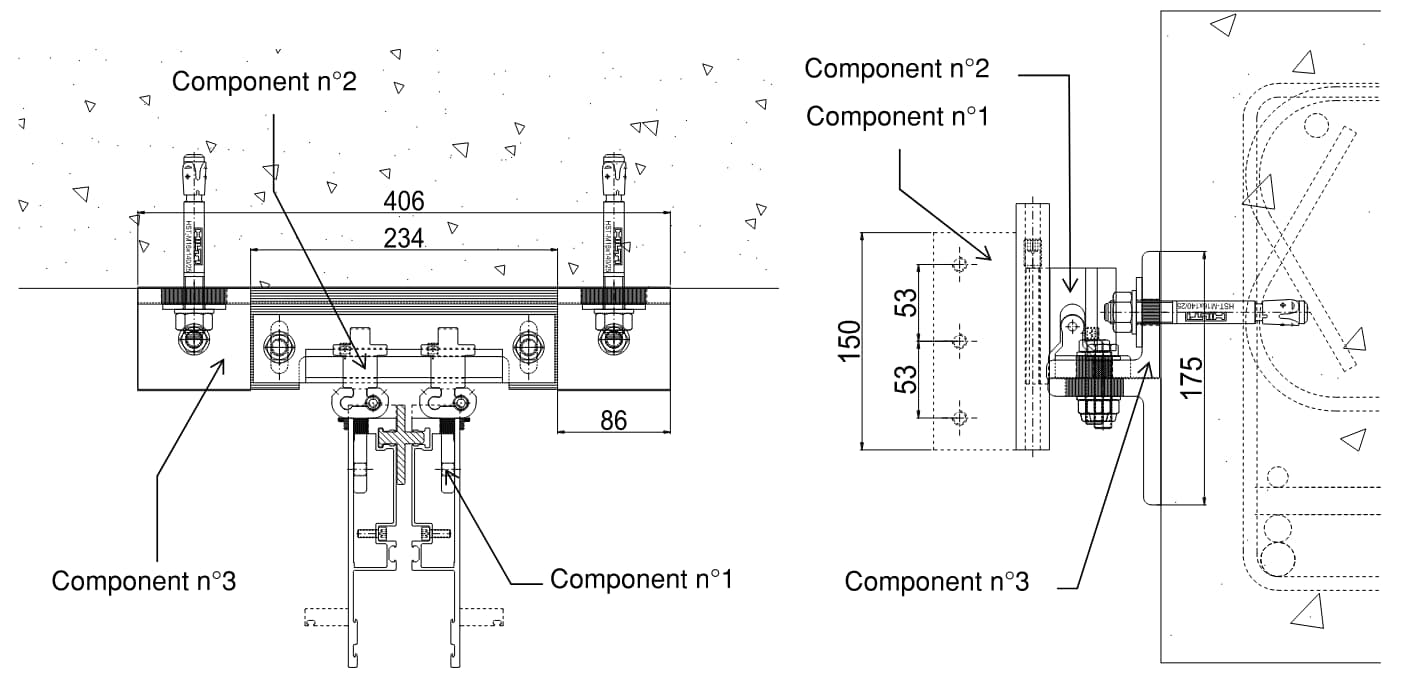Material Properties, Elastic-Plastic Response and Sustainable Impact
Downloads
DOI:
https://doi.org/10.47982/jfde.2023.1.02Keywords:
façades and cladding components, material optimisation, elastic-plastic, elastic-hardening analysisAbstract
This paper commences with a scientific literature review of current research that underlines the environmental benefits to be gained from using smaller quantities of raw materials in the construction industry, with particular emphasis on a sustainable approach to façade design. Life cycle assessment modelling is advocated to validate the sustainability of building structures to achieve optimal solutions. A real-life application of the design of an aluminium façade bracket is presented, demonstrating that a weight reduction of up to 35-45% is attainable by exploiting the post-elastic properties of a material. The work described ranges from a discussion of the current conventional numerical techniques adopted by the industry to the most recent and advanced computational methods permitted by the introduction of Eurocode 9. This code facilitates a substantial enhancement in structural performance by incorporating an evaluation of the material's elastic-hardening behaviour and allows for a noteworthy reduction in component size and increased geometric design flexibility.
How to Cite
Published
Issue
Section
License
Copyright (c) 2023 Augusto Mastropasqua, Mauro Stefani, Paolo Rigone, Enrico Sergio Mazzucchelli, Paolo Giussani, Morteza Ammari

This work is licensed under a Creative Commons Attribution 4.0 International License.
Authors or their institutions retain copyright to their publications without restrictions.
References
Abu-Rayash, A. & Dincer, I. (2019). Sustainability assessment of energy systems: A novel integrated model. Journal of Cleaner Production, 212, 1098-1116. https://doi.org/10.1016/j.jclepro.2018.12.019 DOI: https://doi.org/10.1016/j.jclepro.2018.12.090
ANSI/AISI360-16. Code of standard practice for steel buildings and bridges. American Institute of Steel Construction, 2016.
Akadiri, P. O., Chinyio, E. A. & Olomolaiye, P. O. (2012). Design of a sustainable building: A conceptual framework for implementing sustainability in the building sector. Buildings, 2(2), 126-152. https://doi.org/10.3390/buildings2020126 DOI: https://doi.org/10.3390/buildings2020126
Anderson, J. E. & Silman, R. (2009). A life cycle inventory of structural engineering design strategies for greenhouse gas reduction. Structural Engineering International, 19(3), 283-288. https://doi.org/10.2749/101686609789675918 DOI: https://doi.org/10.2749/101686609788957946
AS4100:1998 (R2016) + AMDT1-2012. Steel structures. Technical committee BD/1, Australian Standards, 2016.
Bedon, C., Amadio, C. & Noé, S. (2019). Safety issues in the seismic design of secondary frameless glass structures. Safety, 5(3), 80. https://doi.org/10.3390/safety5030080 DOI: https://doi.org/10.3390/safety5040080
Bi, L., Zuo, Y., Tao, F., Liao, T. W. & Liu, Z. (2017). Energy-aware material selection for product with multicomponent under cloud environment. Journal of Computing and Information Science in Engineering, 17(3), 031004. https://doi.org/10.1115/1.4036103 DOI: https://doi.org/10.1115/1.4035675
CEN. (2007). Eurocode 3: Design of steel structures – Part 1-1: General structural rules and rules for buildings (EN1993-1-1:2005).
CEN. (2007). Eurocode 9: Design of aluminium structures – Part 1-1: General structural rules (EN1999-1-1:2007).
CEN. (2012). EN15804:2012 + A2:2019 - Sustainability of construction works – Environmental product declaration – Core rules for the product category of construction products.
CEN. (2012). DS/EN 15978:2012 - Sustainability of construction works – Assessment of Environmental Performance of Buildings – Calculation Method.
CEN/CENELEC. (1994). Mandate M/108, Curtain walling – 04/33 External walls (including cladding), internal walls and partitions.
CNR-DT 210/2013. Istruzioni per la Progettazione, L’esecuzione ed il Controllo di Costruzioni con Elementi Strutturali di vetro [Guide for the Design, Construction, and Control of Buildings with Structural Glass Elements]. National Research Council of Italy. http://www.cnr.it/it/node/2630
CPR305/2011. Regulation (EU) No 305/2011 of the European Parliament and the Council.
EN 13830. (2015). Curtain walling – Product standard. CEN European Committee for Standardization.
Gardner, L., Yun, X., Walport, F. The Continuous Strength Method – Review and outlook. Engineering Structures, 275 (2023) 114924, https://doi.org/10.1016/j.engstruct.2022.114924 DOI: https://doi.org/10.1016/j.engstruct.2022.114924
GEF. Global Environment Facility, https://www.thegef.org/
Georgantzia, E., Gkantou, M., Kamaris, G.S. Aluminium alloys as structural material: A review of research. Engineering Structures, 227 (2021) 111372, https://doi.org/10.1016/j.engstruct.2020.111372 DOI: https://doi.org/10.1016/j.engstruct.2020.111372
Geyer, R. (2007). Life cycle greenhouse gas emission assessments of automotive material: The example of mild steel, advanced high strength steel and aluminum in body in white applications. Methodology report. WorldAutoSteel.
Maxineasa, S. G., Isopescu, D. N., Baciu, I. R. & Lupu, M. L. (2021). Environmental performances of a cubic modular steel structure: A solution for sustainable development in the construction sector. Sustainability, 13(21), 12062. DOI: https://doi.org/10.3390/su132112062
Makenya, A. R. & Nguluma, H. (2007). Optimization of building materials and designs towards sustainable building construction in urban Tanzania. In CIB World Building Congress, Construction for Development (pp. 2083-2093).
Radlbeck, C., Dienes, E. & Kosteas, D. (2006). Aluminium structures – A sustainable future? Structural Engineering International, 16(4), 339-344. https://doi.org/10.2749/101686606779695994 DOI: https://doi.org/10.2749/101686606778995146
Sadollah, A., Nasir, M. & Geem, Z. W. (2020). Sustainability and optimization: From conceptual fundamentals to applications. Sustainability, 12(5), 2027. https://doi.org/10.3390/su12052027 DOI: https://doi.org/10.3390/su12052027
Sarma, K. C., Adeli, H. (2002). Life-cycle cost optimization of steel structures. International Journal for Numerical Methods in Engineering, 55(12), 1451-1462. DOI: https://doi.org/10.1002/nme.549
Wallace, R. J., Marvuglia, A., Benetto, E. & Tiruta-Barna, L. (2014). A new approach to optimization with life cycle assessment: Combining optimization with detailed process simulation. In J. Suzuki & K. Koyamada (Eds.) International Conference on Computational Science and Its Applications (pp. 707-720). Springer. https://doi.org/10.1007/978-3-319-09177-8_51 DOI: https://doi.org/10.1007/978-3-319-09150-1_52
Wang, N. & Adeli, H. (2014). Sustainable building design. Journal of Civil Engineering and Management, 20(1), 1-10. https://doi.org/10.3846/13923730.2013.872724 DOI: https://doi.org/10.3846/13923730.2013.871330
Webster, M. D. (2004). Relevance of structural engineers to sustainable design of buildings. Structural Engineering International, 14(3), 181-185. https://doi.org/10.2749/101686604777963887 DOI: https://doi.org/10.2749/101686604777963874
Zabihi, H., Habib, F., Mirsaeedie, L. Sustainability in building and constructions: revising definitions and concepts. International Journal of Emerging Science and Engineering, 2(4), 570-578, December 2012.
